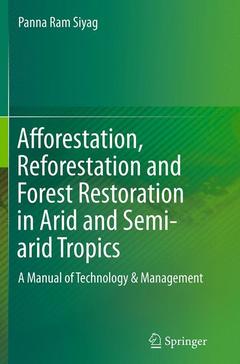Description
Afforestation, Reforestation and Forest Restoration in Arid and Semi-arid Tropics (2nd Ed., Softcover reprint of the original 2nd ed. 2014)
A Manual of Technology & Management
Author: Siyag Panna Ram
Language: English
Subjects for Afforestation, Reforestation and Forest Restoration in...:
Keywords
Publication date: 08-2016
Support: Print on demand
Publication date: 10-2013
295 p. · 15.5x23.5 cm · Hardback
Description
/li>Contents
/li>Comment
/li>
Foreword.- Preface.- Acknowledgement.- PART 1 TECHNOLOGY.- Chapter 1 Introduction.- 1.1 The imperative of afforestation and reforestation.- 1.1 Afforestation and reforestation for conservation.- 1.2 Afforestation and reforestation for subsistence economy and livelihoods.- 1.3 Afforestation, reforestation, forest restoration and tree planting.- 1.4 Afforestation for industrial-commercial purposes.- 1.5 The technology of afforestation
1.6 Participation of local communities.- 1.7 Constraints in afforestation and reforestation.- 1.8 Constraints specific to arid and semi-arid areas.- 1.9 Costs in afforestation.- Chapter 2 Nursery Techniques.- 2.1 Establishment of a new nursery.- 2.2 Plant production plan.- 2.3 Planning seasonal activities.- 2.4 Procurement and storage of seeds.- 2.5 Procurement of manure, clay and sand.- 2.6 Procurement and storage of polypots.- 2.7 Filling the polypots.- 2.8 Preparing seedbeds and motherbeds.- 2.9 Sowing seeds in polypots and beds.- 2.10. Transplanting and potting.- 2.11 Irrigating plants in pots and beds.- 2.12 Weeding and cleaning.- 2.13 Protection from insects and pests.- 2.14 Pot turning.- 2.15 Preparing and planting cuttings.- 2.16. Culling, selection and grading.- 2.17 Transportation of plants.- Chapter 3 Site Selection, Survey and Treatment Plan.- 3.1 Site Selection.- 3.2 Surveying a site using chain & compass
3.3 Plain table survey.- 3.4 Tachymetric survey.- 3.5 Advanced automatic surveying equipment.- 3.6 Setting out contours with hydrostatic level.- 3.7 Setting out engineering structures with hsl.- 3.8 Site treatment plan.- Chapter 4 Fencing Work.- 4.1 Stone wall fence.- 4.2 Ditch-cum-bund fence.- 4.3 Barbed-wire fence.- 4.4 Live-hedge in fencing.- 4.5 Entrance gate and inspection path.- Chapter 5 Soil-and-Water Conservation Works.- 5.1 Alignment of structures.- 5.2 Digging of contour trench.- 5.3 Digging of v-ditch.- 5.4 Digging of pits.- 5.5 Contourdike-cum-terraces.- 5.6 Bench terraces and gradoni.- 5.7 Contour bunds and contour furrows.- 5.8 Vegetative barriers.- 5.9 Loose-stone checkdams.- 5.10 Stopdams and weirs.- 5.11 Earthen embankments.- Chapter 6 Planting, Regeneration, Aftercare and Maintenance.- 6.1 Time and season for planting.- 6.2 Transporting plants to pits.- 6.3 The operation of planting.- 6.4 Making of pit-saucers.- 6.5 Beating up casualties.- 6.6 Ensuring continued protection.- 6.7 Replacement of casualties.- 6.8 Removal of weeds.- 6.9 Hoeing the plants.- 6.10 Watering the plants.- 6.11 Fertilising and manuring.- 6.12 Growth of plants.- 6.13 Tending the rootstock.- 6.14 Maintenance of s&wc structures.- 6.15 Plantation maintenance in sand dunes.- 6.16 Long-term maintenance.- PART 2 MANAGEMENT.- Chapter 7 Costing and Estimation of Works.- 7.1 Schedule of labour rates.- 7.2 Model treatment plans.- 7.3 Units of measurement and conversion tables.- Chapter 8 Organizing and Staffing Programmes and Projects.- 8.1 Organisation structure and staffing.- 8.2 Organisational effectiveness.- Chapter 9 Planning, Monitoring and Evaluation.- 9.1 Planning time-critical activities.- 9.2 Monitoring, evaluation and review.- 9.3 Quality control and work productivity.- 9.4 Recordkeeping and documentation.- Chapter 10 Ensuring Sustainability.- 10.1 Institutional sustainability.- 10.2 Resource sustainability.
These books may interest you

Forest Development in Cold Climates 210.99 €



